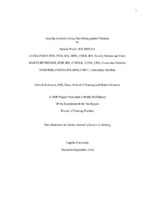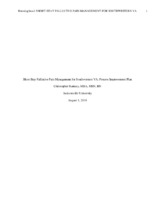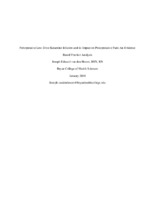| dc.contributor.advisor | Forsythe, Lydia L. | en |
| dc.contributor.advisor | Bressie, Marylee | en |
| dc.contributor.advisor | Owens, Dorotha | en |
| dc.contributor.author | Wisor, Pamela G. | en |
| dc.date.accessioned | 2016-12-22T16:18:52Z | |
| dc.date.available | 2016-12-22T16:18:52Z | |
| dc.date.issued | 2016-12-22 | |
| dc.identifier.uri | http://hdl.handle.net/10755/621173 | |
| dc.description.abstract | <p>Assisted living (AL) is a growing lifestyle choice option available to the ailing aged in the United States. Increases in chronic disease may predispose this population to acute and chronic pain due to increased longevity with medical advances. The elderly populations in these facilities are frail with multiple chronic illnesses and cognitive and/or functional impairment adding to the difficulty in effective pain management practices. The burden of providing pain management in AL is on the nursing assistant whose education and scope of practice may not include performing pain assessment that impact resident quality of life and outcomes. Continuing education in pain management in AL settings may improve the ability of unlicensed staff members to provide pain management strategies to meet best practice guidelines. This project identifies nursing assistants’ knowledge of pain management after receiving education in pain management. A single group pre-post test design using the Palliative Care Quiz for Nursing (PCQN) and Frommelt’s Attitudes Toward Care of the Dying Scale (FATCOD) measured the effect of a pain management educational intervention. Results support the need for pain management continuing education fro nursing assistants caring for residents in AL.</p> | en |
| dc.format | Text-based Document | en |
| dc.language.iso | en | en |
| dc.rights.uri | http://creativecommons.org/publicdomain/mark/1.0/ | * |
| dc.subject | Pain Management | en |
| dc.subject | Assisted Living | en |
| dc.subject | Nursing Assistant | en |
| dc.subject | Continuing Education in Nursing | en |
| dc.subject.mesh | Pain Management | en |
| dc.title | Gaps in Pain Management in Assisted Living | en |
| dc.type | DNP Capstone Project | en |
| dc.rights.holder | <p>
All rights reserved by the author(s) and/or publisher(s) listed in this item record unless relinquished in whole or part by a rights notation or a Creative Commons License present in this item record.
</p><p>
All permission requests should be directed accordingly and not to the Sigma Repository.
</p><p>
All submitting authors or publishers have affirmed that when using material in their work where they do not own copyright, they have obtained permission of the copyright holder prior to submission and the rights holder has been acknowledged as necessary.
</p> | |
| dc.description.note | This work has been approved through a faculty review process prior to its posting in the Virginia Henderson Global Nursing e-Repository. | en |
| thesis.degree.grantor | Capella University | en |
| thesis.degree.level | DNP | en |
| dc.primary-author.details | Pamela Wisor, DNP(c), MSN Ed, BSN,RN | en |
| thesis.degree.year | 2016 | |
| dc.type.category | Full-text | en |
| dc.evidence.level | Other | en |
| dc.research.approach | Translational Research/Evidence-based Practice | en |
| dc.subject.cinahl | Assisted Living | en |
| dc.subject.cinahl | Pain--Prevention and Control | en |
| dc.subject.cinahl | Aged | en |
| dc.subject.cinahl | Education, Continuing | en |
| dc.subject.cinahl | Nursing Assistants | en |
| dc.description.reviewtype | None: Degree-based Submission | en |
| dc.description.acquisition | Self-submission | en |





